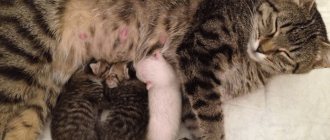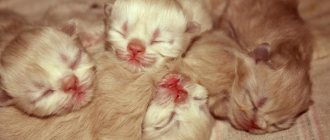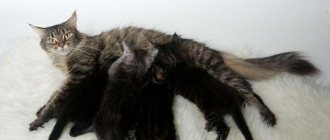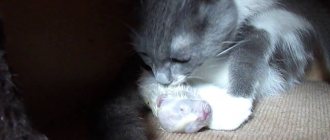The period of pregnancy and childbirth in domestic animals, in this case cats, is a process that occurs in natural conditions, without human intervention.
But there are also exceptions. For example, if a cat has caught an infection, gives birth for the first time, or there are dead kittens in the litter. In such cases, the question “how to help a cat give birth” is natural. Here, of course, you cannot do without the help of the owner and the veterinarian, but how do you understand that the animal needs help and what needs to be done in such cases? Let's figure it out together.
The cat should give birth mainly at home
If a cat’s pregnancy proceeded calmly, smoothly, without complications, then she should give birth without any problems. The main thing is not to be nervous, as the animal easily picks up the mood and vibrations emanating from the owner and also begins to noticeably worry, which can lead to problems during childbirth.
The cat should give birth primarily at home. This is preceded by two reasons at once - a feeling of calm and safety in one’s native territory and a low risk of contracting a bacterial infection.
If a cat’s pregnancy is difficult and with pathological processes, this is also not a death sentence for her giving birth in a veterinary clinic. The owner just needs to take the cat to an appointment in advance so that the veterinarian carefully examines the animal and is aware of possible problems that appear during childbirth. It is worth noting that this should not be an ordinary therapist, but a veterinary obstetrician.
If the animal has health problems, doctors recommend a cesarean section.
If the owner doubts his abilities and is afraid to help the cat get wet, then it is better to leave her at the clinic, where veterinarians will look after her around the clock. This is especially true if the animal has heart or respiratory problems. As a rule, for such diseases, doctors recommend a cesarean section, and a little later sterilization.
How does childbirth occur in cats?
Cats bear offspring for approximately 2.5 months. During one birth, 1-2 kittens are born, as well as 6-7. The process itself takes several hours and consists of several stages. If you are helping your cat give birth, then you need to know how everything usually goes:
- pushing – kittens pass through the birth canal in 4-5 pushing;
- birth - kittens come out in the amniotic sac, less often without it;
- starting breathing - the cat breaks the bubble and licks the born kitten, removing mucus from the respiratory tract;
- rupture of the umbilical cord, eating the placenta - after the kittens, an afterbirth (placenta) comes out, which the cat eats. As many babies are born, so many placens should come out.
Human assistance may be required at each stage of the birth of kittens. When all the babies have come out, all the amniotic sacs have been ruptured, the cat has licked all the babies and they are suckling milk - everything is done. Further assistance will be reduced to proper care of the newborn pet.
To know for sure that all the kittens have come out, it is advisable to first do an ultrasound and count the fetuses. Then there will be no cause for concern if the number of babies born coincides with the number given by the veterinarian.
The kitten should be born feet first or head first
It's easy and interesting to communicate here. Join us!
wait some more time. and then pull. Just be careful not to tear off your head. and this is me now, no joke. Look for a veterinarian at home, there is probably one in your city. Or try to pull it yourself, only very carefully, during a contraction, by the kitten’s scruff, you can lubricate the cat’s vagina with Vaseline.
I heard that if there is something wrong with a kitten, the cat will eat it. In general, don’t be nervous, everything will be fine with the cat. It’s better not to interfere, maybe massage your tummy.
Vaseline oil (this is like an emergency aid if the kitten does not pass, is stuck) Just when the kitten walks feet first, it often gets stuck with its head, sometimes the fetal sac ruptures, and it is difficult for the kitten to get out, since in its sac it turns out to be more slippery and comes out easier out. This is where Vaseline oil is used - but not everyone can cope with this process - you need to lubricate the vulva with Vaseline and pour a little Vaseline inside the birth canal, but very carefully, wrap the legs and body of the stuck kitten with gauze or cotton cloth and slowly pull it out with screw-like movements kitten at the time of the next contractions. You can pull at the withers, but very carefully. Vaseline will act as a lubricant.
Need an assistant. If the cat pinched the kitten out of pain and fear, for example, in the neck area (i.e. body outward, head inward). Then take a cloth like old gauze or an old waffle towel. The cat is placed in the “pooping” position and the baby is pulled down by the scruff of the neck (not by the body or limbs), swinging from side to side. Ideally, synchronously with the contractions, but sometimes the cat gets so stuck that the contractions stop and time runs out. Then you'll have to carry on without them. An assistant fixes the cat. Everything must be done very quickly, but without hysterics and haste!
Just don’t paw or squeeze too hard. ! If you do nothing, the kitten may die from suffocation
How many kittens did your cat give birth to? Boy or girl? Did you solve the problem using the advice of the respondents?
In the vast majority of cases, during childbirth, a cat only needs moral support from a person. As a rule, some breeds require help - extreme Persians, Rexes, Orientals. Often pregnancy in these breeds is complicated by polyhydramnios and large fetuses. Often cats of these breeds carry their babies to term.
Correct care for a woman in labor
In the wild, cats give birth on their own, but in domestic cats, their natural instincts are muted. For this reason, it is desirable that the owner be nearby during childbirth and can provide the necessary assistance in a timely manner. It is especially needed for a cat giving birth for the first time. The pet can only guess what will be required of her. The owner’s task is to act competently and, if necessary, call a veterinarian.
Correct actions with the amniotic sac
If the bubble with the kitten inside is not damaged, if the fetus lies correctly head first, then your help will not be required. You need to intervene in the following cases: - if the bubble is torn, prepare a clean cloth, wrap it around the kitten and gently pull at the next contraction; - if the bladder is torn and the kitten is walking butt, pull without waiting for a contraction, speed is more important so that the baby does not suffocate.
If the cat does not chew the amniotic sac, this must be done for her. You will need sterile scissors. Act quickly - if you wait more than half a minute, the kitten may suffocate.
If the kittens are too big
It is difficult for a cat to give birth to large babies. It will also be difficult for you to remove the kitten; it will slip back into the vagina. If your cat's vulva is dry, lubricate it with Vaseline or lubricant. Proceed as follows: - wait for the next contraction when the baby approaches the vulva; - insert the index finger of a sterile-gloved hand into the vulva a few centimeters and move the skin towards the anus; - as soon as the kitten appears, grab it and move it slightly to help it come out. Determine the intensity of the impact yourself individually.
What to do if a kitten gets stuck
A few hours before birth, kittens take a forward-facing position. But sometimes babies change position or their head is turned to the side, making it difficult to exit the vulva. To help a stuck kitten be born, lubricate the vulva with lubricant or Vaseline and with a sterile gloved hand perform the following manipulations: - carefully insert your finger into the baby’s mouth, if the amniotic sac allows it; — turn the kitten’s head in the right direction so that the cat’s contractions push it further; - press on the cat's perineum at the bottom of the anus - this will cause a contraction, and the baby will not be able to return back.
We do the same if the kitten moves forward with its sacrum - grab it by the paws and guide it along the birth canal.
It happens that for some reason kittens die in the womb. In this case, they will still be born naturally. The cat will go into labor, and if your help is needed, you can act less carefully. It is important that everything is in order with the cat, so if the fetus is stuck, feel free to pull on any part of the body.
How to induce labor at home
It should be understood that there are a large number of drugs on the market. In any case, it is better to consult a veterinarian who will take into account the individual characteristics of the cat. A number of drugs are excellent at inducing and accelerating the birth of your pet.
Let's look at the main medications that are used for stimulation:
Lack of calcium leads to the development of eclampsia - acute postpartum depression, which negatively affects the nervous system and causes severe convulsions. In advanced cases it leads to the death of the animal.
Veterinary practice knows cases when labor can be induced without the use of medications. Let us note two main methods.
Option one
The owner puts on gloves. Puts the cat in a position where she goes to the toilet "in large quantities." Next, massage the abdomen in a circular motion. After a couple of minutes, dip your finger in Vaseline oil and insert it into the cat’s vagina about a centimeter. Circular movements are repeated again. Mechanical actions help stimulate and speed up labor.
Option two
When oxytocin is contraindicated for a cat for some reason or the owner does not risk using it, then the following method will come to the rescue. Using a disposable syringe, mix 2 ml of ascorbic acid, 4 ml of glucose, 4 ml of calcium gluconate. We administer intramuscularly or intravenously, but only after the female has given birth to her first baby.
For every 5 kg of weight, 1 ml of the resulting solution is sufficient. It is also used after childbirth as a prophylaxis against eclampsia.
What not to do during childbirth
In the desire to help a giving birth cat, it is important not to harm. There are a number of actions that are prohibited. What you shouldn't do:
- do not press on the stomach, this will cause pain to the cat and harm the kittens inside;
- do not pull the umbilical cord so that it does not break or cause a hernia in the cat;
- do not burst the bladder if the woman in labor is ready to do it herself;
- Do not give injections without your veterinarian's approval and do not use medications to induce normal labor.
- do not use instruments without sterilization to avoid infection;
- Do not take kittens away from your cat immediately after birth.
After the baby arrives
- When the kitten appears more than halfway out of the way, you can slightly pull it up. Under no circumstances should you make sudden jerks or turns. Movements should be neat and smooth.
- Following the fetus, the placenta will appear. Pull it up too.
- If the kitten was born with an intact bladder, tear it at the head.
- Cut the umbilical cord at a distance of 2 cm.
- Make sure your cat eats the placenta. This is a very light food and, at the same time, provides all the necessary substances.
- Place the newborn next to the mother. She should actively lick him. The kitten should squeak, and at this time we are waiting for the next one.
If the kitten does not squeak and the mother does not pay attention to it, you need to free it from the remnants of the amniotic sac and wipe it with a dry cloth. This will stimulate you to start breathing on your own. If the baby is not breathing, turn him upside down and actively stroke his body. Blow lightly into his mouth. Press down on your chest until it bends about 1/3. This will help the lungs expand. As soon as the baby squeaks, give it to the cat.
In the vast majority of cases, difficulties occur only with the first kitten. The rest are born without complications. You just need to make sure that during the period of pushing the cat does not crush the already born kittens.
When to call the vet
Keep your veterinarian's number handy. You may need to seek qualified help at any time if something goes wrong. Delay during childbirth in a difficult situation is fraught with the death of both the kittens and the cat itself.
An urgent call to the veterinarian is required if:
- a kitten cannot be born for more than an hour;
- the kitten is stuck, walking incorrectly, and you cannot help the animal;
- The cat’s body temperature is too high or, on the contrary, has decreased;
- a liquid with an unpleasant odor and a strange color is released from the vulva;
- the cat has heart palpitations;
- the cat is unable to move, labor is weak or absent.
Call a specialist if you have any doubts, to be on the safe side, at least consult by phone.
The consequence of a difficult birth in a cat can be various complications. It is not possible to diagnose and treat them on your own. Therefore, a cat that has given birth should be shown to a veterinarian within a week and, if necessary, examined.
When delivering a cat at home, maintain composure. Fluffy mom sensitively reads your mood. Act clearly and correctly, and soon newborn babies will delight both of you.
Interesting topics
What else to read:
- Breeds of dogs that love catsContents of the articleThe main breeds of dogs that are friends with catsDogs that can.
- Why do cats bite Contents of the article Errors in handling cats Physiological reasons Educational fight against aggressive ones.
- How to make your home safe for a catContents of the articleToys that are dangerousIndoor plantsUnlocked windowsChemical hazardElectrical wiresHousehold appliances Starting.
- Comfortable holiday in the country with your beloved cat Contents of the article Arguments of opponents of holiday with a pet in the country Preparing for the trip.
© Veterinary clinic "Belanta", 2004—2021, Moscow
Recommendations for the owner
It was not possible to cope with the defect using the manipulations described above; it will not be possible to correct it, since modern methods of veterinary practice do not allow this. The defect is considered recessive and genetic, so doctors do not recommend breeding a cat with the same cat in the future. For preventive purposes during pregnancy, the owner of the female will need to provide her with a proper and balanced diet. It is important to remember that during this period the pet needs increased consumption of the components required for the cat’s body. A cat's diet must include lean meats, vegetables, cereals and eggs. Several times a week it is permissible to diversify the menu with fermented milk products and boiled sea fish.
Deviations in the first stage of labor in cats.
Among the deviations during childbirth, in addition to primary inertia, quite rare disorders also occur, such as torsion and rupture of the uterus. Such deviations can lead to serious complications in late pregnancy and the first stage of labor. When the uterus twists, the blood supply is disrupted and normal passage of the fetus becomes impossible. It is believed that twisting occurs, as a rule, as a result of jumping or some sudden movements that cause oscillatory movements of the uterus in late pregnancy. Ruptures are most often the result of blows or other violent trauma, as well as very strong strain due to constipation. Tears that occur during childbirth have the same symptoms as twisting. There are known cases of ruptures that occurred in the early stages of pregnancy, in which kittens continue to develop outside the uterus, in the maternal abdominal cavity. In such cases, the placenta is attached to one of the abdominal organs, but usually such fetuses do not go through the full development period, and, of course, cannot be born without abdominal surgery.
Deviations in the second stage of labor in cats.
Secondary inertia occurs during the prolonged second stage, and may be caused by obstructive dystocia, muscle fatigue, or excessive pain. Obstructive dystocia can have many causes, but most often occurs due to a malunion of the pelvis (after a fracture), as well as due to abnormal presentation, position or development of the fetus. Pauses in labor, as already described, are certainly not inertia, since the cat clearly feels well, labor resumes normally, and the kittens are born alive and healthy. The important difference is that secondary inertia follows some difficulty or delay in the birth, and cats appear restless and exhausted.
The birth is over
By feeling the belly, you can determine if there are still kittens left. If you did not inject oxytocin, then half an hour after the birth of the last baby, the stomach becomes soft. If oxytocin was administered, it will take longer.
Monitor your vaginal discharge . They may be bloody, but there should not be obvious bleeding. If the discharge does not stop for more than a day, consult a specialist. You might need his help. Also make sure that the number of placentas born matches the number of kittens born.
Give the cat cottage cheese, sour cream, and egg yolk. You can give vitamin preparations. Make sure there is always clean water near it. Disturb the animal as little as possible, and it will quickly rehabilitate itself.
Source
Malpresentation of the fetus.
Reverse (or tail) presentation, when the kitten is positioned not with its head, but with its tail forward, is very common in cats. So much so that it can even be called a normal phenomenon, which usually does not cause any delays during childbirth. However, if the first kitten walks tail first, then a delay is quite possible due to the lack of wedge-shaped pressing of the liquid-filled membrane with the head. Ultimately, the birth usually ends successfully. However, there is an increased risk of the fetus drowning in its own fluid if the time until the placenta separates when its nose is freed is too long.
What kind of help will you need?
So, we figured out how to induce and stimulate labor. But in some cases complications may occur. You will need the owner's help. Let's look at the most common cases and specific actions. It is especially useful for people to know when a cat gives birth for the first time:
The fetus is large and does not pass through the uterus
We have found that it is preferable for a kitten to be born head first. There is nothing wrong with walking feet first, but it often causes complications for the cat. What to do if the fruit is large?
Deviations in addition (Malposture).
For the normal course of labor in cats, the position of the fetal head is very important. With brachycephaly (a head with a relatively large transverse diameter), the cat experiences difficulty when the kitten's head passes into the pelvic region. Lack of a wedge-shaped muzzle increases the risk of the head tilting to the side, down between the front legs, or onto the chest. Occasionally, one or both front legs may arch backward along the body, and when the fetus is positioned tail first, one or both hind legs may arch forward. All the options described can lead to a temporary delay in labor and require additional effort from the cat, and even, in the worst case, to complete obstruction. Note.
Malposture Posture
How to help a cat during childbirth
Cats are animals with highly developed natural instincts. Therefore, as a rule, intervention in the lambing process is not required. However, every pet is dear to its owner. Therefore, the cat owner must have an understanding of cat pregnancy and childbirth in order to help her or provide assistance in case of complications. If there are no pathologies, then the cat will give birth to offspring on its own. And the owner’s role will be reduced to observation, organizing a place for lambing and good feeding.
Before birth
The cat will let you know that birth is approaching with its behavior. They do not leave their owners, they can meow loudly and fuss. By the time of birth, you need to prepare a place where both the cat and future kittens will be comfortable. This can be an ordinary box lined with soft cloth. It needs to be placed in a warm, dry place, preferably where the woman in labor will be least disturbed. In addition, the place must be protected from drafts. You also need to close all cabinets - this is a favorite place for cats. Just before giving birth, the animal does not leave the nest. About a week before giving birth, the animal is switched to light nutritious food, such as chicken.
For medical supplies and instruments, be sure to prepare oxytocin, cotton wool, alcohol, scissors, dry wipes, and toilet paper.
Signs of approaching labor
Signs of impending labor in cats can appear either the day before birth or one to two hours before it. It depends on the characteristics of each cat’s body. In cats giving birth for the first time, symptoms begin earlier because the animal’s body takes more time to adjust.
Signs of imminent labor are as follows:
- The animal loses its appetite, it drinks a lot - this is how the body prepares for lambing ;
- Manifestation of lethargy - the cat spends almost all of its time in the place that it has chosen for birth;
- The active movement of the abdomen is noticeable, since the kittens move energetically before the onset of contractions, taking the most convenient position for passing the birth canal. If there are many kittens or they are large, then such a movement can begin two days before birth;
- The cat actively licks the genital slit, because... vaginal discharge appears. She maintains cleanliness as this is important to prevent infection;
- The removal of a plug that covered the uterus during pregnancy. If the plug comes out, labor will begin within one to two hours;
- Rectal temperature drops to 37 degrees (this prevents bleeding after childbirth and during the process);
- The appearance of colostrum - when you press on the nipples, a white drop appears;
- The cat hunches over, screams and tries to hide - this behavior is possible 4-6 hours before the onset of labor due to the appearance of false contractions. They prepare the appearance of kittens, but do not open the uterus. False contractions help determine the appearance of real contractions.
Stages of the procedure
Specialists note several stages that precede the birth of kittens. The cat walks restlessly, the babies are actively moving in the stomach.
The first stage of labor begins. It lasts up to 24 hours. The cat's body temperature drops by 2-3 degrees. This is a natural process. The cat actively licks the nipples or genitals. In some cases, vomiting is observed. It is better to transfer the expectant mother to a previously prepared nest. There she will feel safe and prepared for childbirth.
The cat's water breaks and her pulse quickens. Breathing is occasionally interrupted. The contractions began. The pet meows loudly, sometimes turning into a scream. The owner calms the cat down by talking and lightly stroking the belly.
The second stage begins. The abdominal and diaphragm muscles are activated. The cat is pushing hard and the baby is gradually moving forward. The amniotic sac partially ruptures and fluid flows from the vagina.
Many owners are interested: is a kitten born feet first or head first? In this, cats copy humans. Like a human baby, a kitten is born head first. But it is worth noting that birth with the pelvis or paws forward should not cause concern to the owner. This is natural for cats.
The mother licks the baby, freeing it from the amniotic sac. Cats often eat this afterbirth. It is rich in vitamins and minerals. But a large amount of afterbirth eaten causes indigestion. The optimal quantity for a female is 2 pieces. In most cases, the cat chews the umbilical cord on its own.
ATTENTION! The number of afterbirths exactly corresponds to the number of kittens. Sometimes their number does not match. This means that one of the placentas remained inside the uterus. It must be removed to prevent inflammation of the genital organs in the future.
The final, third stage comes into force. The animal's uterus comes to rest until the next kitten appears. The break between births lasts from 10 to 60 minutes. The cat can drink and rest a bit.
The time of birth is an individual value. But if they continue for more than 24 hours, you should contact your veterinarian.
The birth process
It is impossible to predict how long labor will last. Even for a cat that gives birth frequently, this process can take varying amounts of time. The average duration of labor is from two to six hours , but there may be a longer period - up to a day.
Lambing is divided into three stages:
- The first stage is contractions;
- The second stage is the birth of kittens;
- The third stage is the release of the placenta.
Lambing begins with uterine contractions, which is accompanied by colorless vaginal discharge. At the end of the first stage, contractions become more pronounced and frequent. The cat is breathing heavily and may make sounds.
The second stage begins with the discharge of amniotic fluid. After this there must be a birth. The period after the water breaks and the kittens appear should not exceed two hours. Otherwise, the help of a veterinarian is required.
After the kitten comes out, the cat must lick it. If she does not do this, then the owner needs to clear the mucus from the nose and mouth.
Kittens may appear one after another, but sometimes there is a gap of up to two hours. You can tell if labor has ended or not by carefully palpating the animal’s abdomen. They are easily felt if they are still there. This examination stimulates labor, but it should be carried out with extreme caution.
The third stage is the release of the placenta after the birth of each kitten. The cat chews the umbilical cord and usually eats the placenta. The cat owner must ensure that the number of kittens and the number of afterbirths coincide. If the placenta remains in the birth canal, it can cause complications after childbirth.
What to do?
First aid and massage
Massage procedures will contribute to the baby’s recovery.
If a newborn cat has twisted paws, first of all, veterinary doctors recommend resorting to massage, which will help improve blood flow to the affected limbs. In addition, the owner needs to try to carefully put the paw in place. If this cannot be done immediately, the manipulation will need to be done gradually. You should not give up, since in newborn babies the cartilage is not yet formed and can be easily straightened.
Prescription of drugs
When contacting a veterinary clinic, the veterinarian may prescribe the use of chondroprotectors for the kitten. In addition, vitamin-mineral complexes will also come to the rescue. They must contain calcium. Sometimes the recovery of a small cat is facilitated by physiotherapeutic procedures prescribed by a veterinarian. It is also permissible to resort to the help of warm compresses, which are applied to inverted paws. Experienced breeders recommend applying splints to injured limbs. For example, it is permissible to use an ice cream stick, which is fixed to the inverted paw.
Baby feeding and complementary feeding
If such a baby is malnourished, then he must be supplemented.
In addition, it is important for kitten owners to ensure that the cat feeds it. Sometimes females refuse these obligations. In this situation, you will need to feed the baby yourself. Artificial mixtures that can be purchased at a pet store will come to the rescue. It is not recommended to use cow's milk for these purposes. This is due to the fact that the breast milk of representatives of the cat family contains significantly more proteins, fats and other elements that are required for the normal growth and development of kittens.
Without these elements, babies will not die, but they will develop much more slowly and may develop chronic illnesses.
If it is not possible to purchase a cat milk substitute, it is permissible to prepare it at home. It is recommended to take cream whose fat content is 10% and dilute it with water in a 1:2 ratio. It should be borne in mind that the prepared mixture should be stored in the refrigerator for no more than a day. Before feeding the kitten, the composition will need to be heated to a temperature of 37 degrees.











